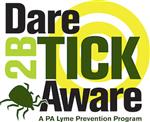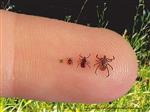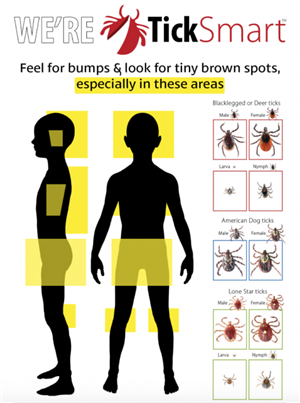-
Ticks

For the past several years, Pennsylvania is the top ranked state for the most reported cases in the U.S. for Lyme Disease. Lyme Disease is a bacterial infection transmitted to humans through the bites of infected deer ticks, especially by the nymphal deer tick. The nymphal deer tick is so small, that many people are not aware when they’ve been bitten by a tick and may not make a connection when they begin to experience symptoms. Symptoms can include fever, headache, general achiness, swollen glands, fatigue, and a possible bullseye rash and symptoms may not appear for weeks, months, or even years after a tick bite. Children and youth are the most susceptible to Lyme Disease, and initial symptoms may go unrecognized and be considered normal childhood illnesses. By the time it is clear there is something wrong, the symptoms are often neurocognitive, usually showing up with behavior changes, changes in performance at school, and psychiatric issues (PA Lyme Resource Network, 2018).

Prevention is key to avoiding a tick bite! Here are a few tips you can follow.
- Avoid exposure in wooded, overgrown areas, and stay on marked trails when hiking.
- Avoid going into the tall grass and brush if you can.
- Sports and athletic fields with well-groomed grass are safer.
- Wear protective clothing such as long sleeves, long pants tucked into socks, and closed-toe shoes.
- Use insect repellent such as DEET on the body or Permethrin on clothes. Be sure to review safety information and assess the risks/benefits of these products. Consult your doctor if you’re hesitant of the products.
- Remove clothing as soon as coming in from outdoors, in an area outside of the house, like a garage.
- Place clothes in a dryer on high heat for at least 10 minutes.
- Perform tick checks as soon as you come in from outside. Important areas to check for ticks include behind the knees, under the armpits, in the scalp, along the waistline, and the back.
- Shower daily.
Places to check for Ticks:
- In/behind ears
- Scalp and hair
- Armpits
- Belly button
- Groin area
- Behind the knees
- In-between toes
- Under any skin folds
(TickEncounter Resource Center, 2018)

Symptoms
Symptoms can include:
- Bull's Eye Rash - Keep in mind that 50% of individuals with Lyme Disease never see a bull's eye rash. The bull's eye rash is a definite indicator that the indiviudal has Lyme Disease.
- Fever
- Headache
- Flu-like symptoms (chills, sweats, nasuea, and muscle aches)
- Bell's palsy (facial paralysis)
- Extreme/persistent fatigue
- Swollen glands
- Exercise intolerance
- Insomnia
- Memory issues and brain fog
It is important to be aware that Lyme disease being left untreated can have a significant effect on a child's life, cognitive function, and their ability to perform well in school. Children are often misdiagnosed with cognitive or behavioral disabilities, before receiving a diagnosis of Lyme Disease.
How to remove a tick
- Use fine-tipped tweezers to grasp the tick as close to the skin’s surface as possible. Apply gloves prior to removing the tick to protect any open cuts on your skin.
- Pull upward with steady, even pressure. Don’t twist or jerk the tick as this can cause the mouth-parts to break off and remain in the skin. If this happens, remove the mouth-parts with tweezers.
- After removing the tick, thoroughly clean the bite area and your hands with rubbing alcohol, or soap and water.
- Never crush a tick with your fingers. Dispose of a live tick by putting it in alcohol, placing it in a sealed bag/container, wrapping it tightly in tape. Never crush a tick with your fingers!
For further information, please go to PA Lyme Resource Network or the Centers for Disease Control.
Additional Resources:
Select a School...
Select a School
- Bradford Woods Elementary School
- Franklin Elementary School
- Hosack Elementary School
- Ingomar Elementary School
- Marshall Elementary School
- McKnight Elementary School
- Peebles Elementary School
- Carson Middle School
- Ingomar Middle School
- Marshall Middle School
- NA Intermediate High School
- NA Senior High School
- NA Cyber Academy


